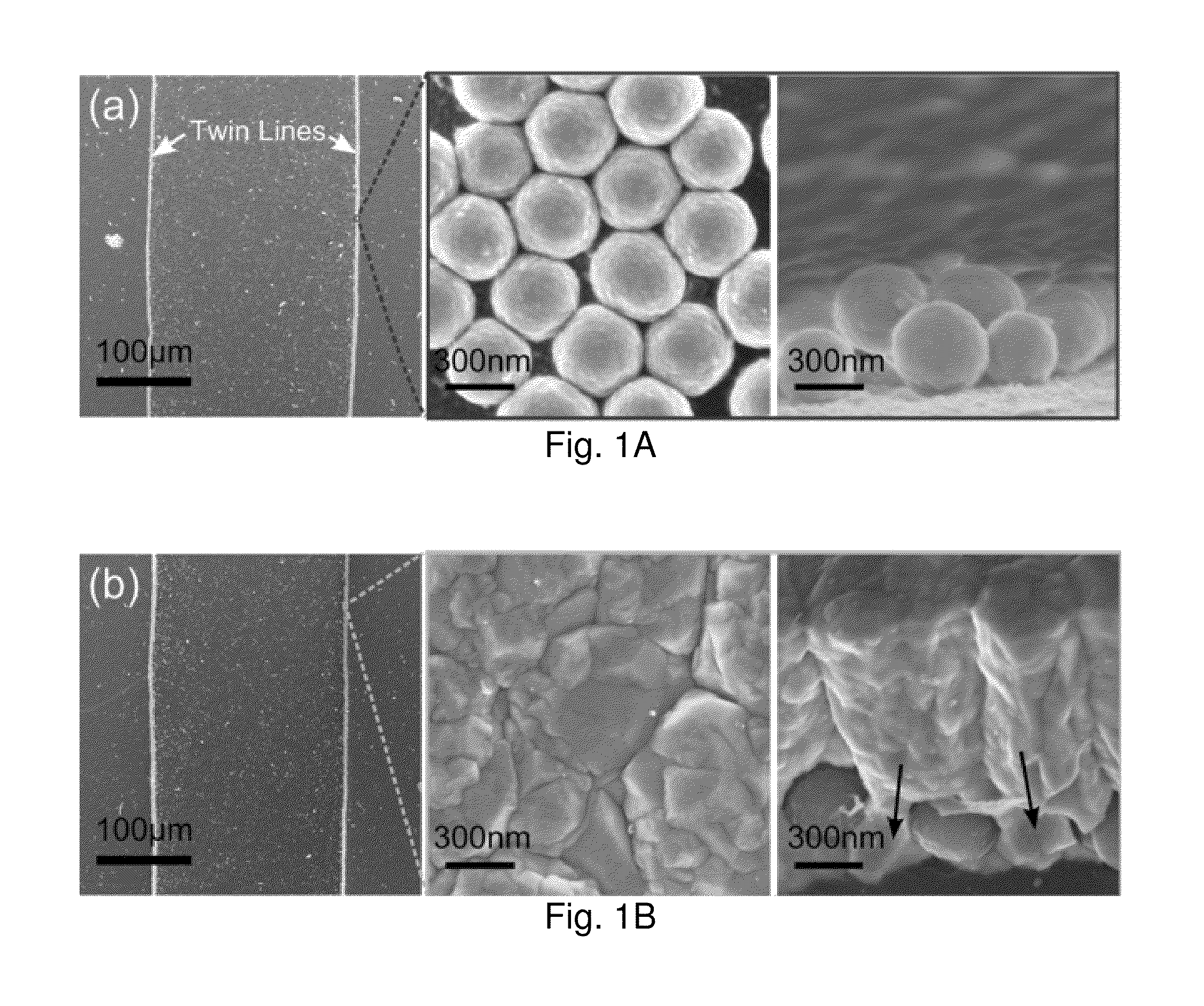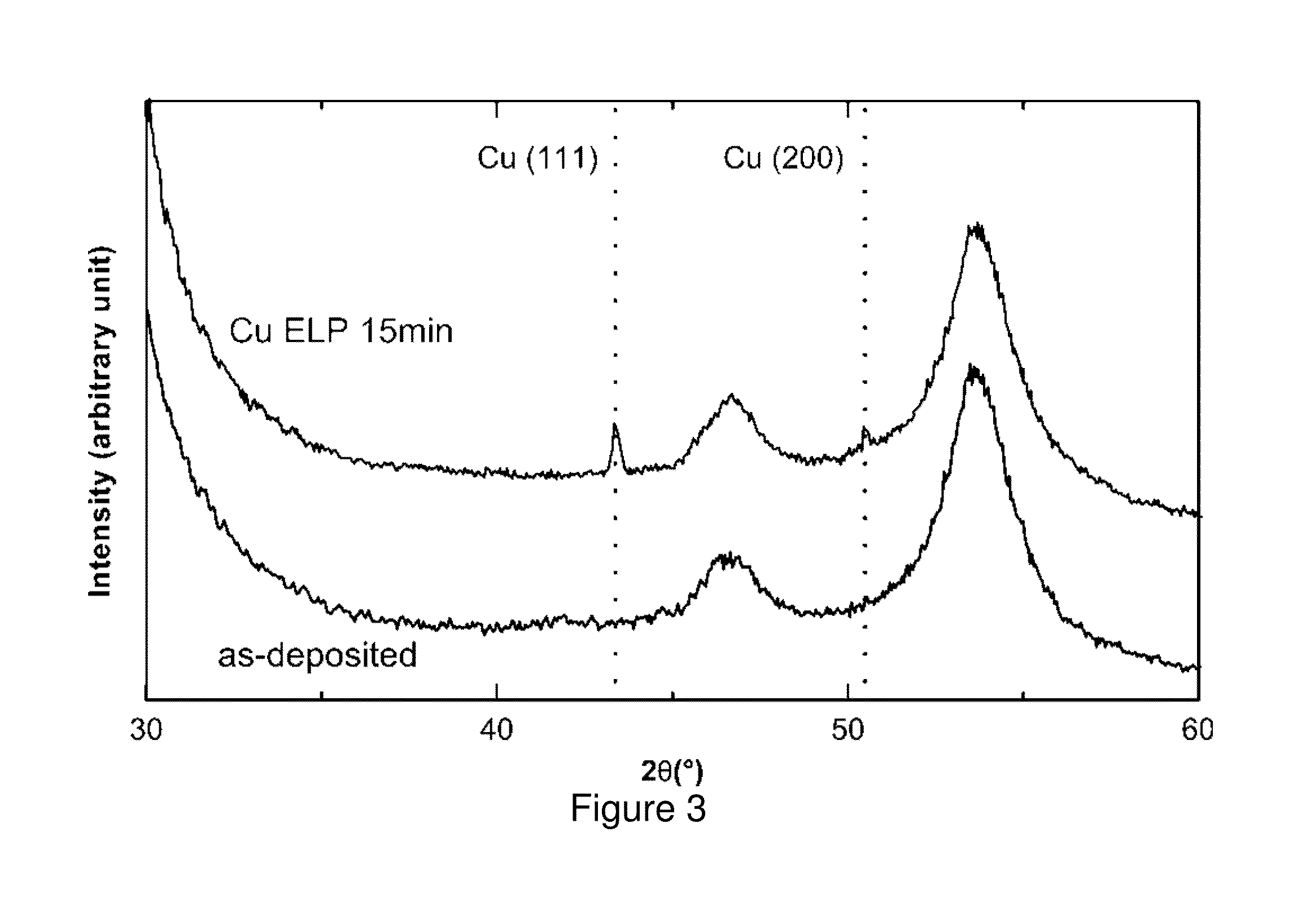Electroless copper plating polydopamine nanoparticles
a technology of copper plating and nanoparticles, applied in the field of electroless plating, can solve the problems of high cost of pd, and material at risk of thermal degradation/deformation
- Summary
- Abstract
- Description
- Claims
- Application Information
AI Technical Summary
Benefits of technology
Problems solved by technology
Method used
Image
Examples
example 1
[0044]PDA-NP was synthesized according to a published protocol (27) with minor modification. The ink was formulated by mixing PDA-NP with distilled deionized (DI) water at a concentration of 0.25 wt % followed by 10 min ultrasonication (3510, Branson). The particle size distribution and zeta potential were characterized by dynamic light scattering (DLS) (ZetasizerNano, Malvern). The PDA-NP average diameter was about 340±55 nm. The zeta potential of PDA-NP was measured as −31.0±0.5 mV, indicative of good stability of the ink dispersion. Particle precipitation was not observed over a 30-day period.
[0045]The viscosity and surface tension were measured as 1.0±0.1 mPa·s by a rotary viscometer (TA1000, TA Instruments) and 72.1±0.1 mN / m by a bubble tensiometer (BP100, Kruss), respectively. These values were close to those of pure water due to the very small PDA-NP loading.
[0046]FIGS. 1A and 1B show typical scanning electron microscope (SEM) images of printed lines of polydopamine nanoparti...
example 2
Materials
[0061]Dopamine hydrochloride (98.5%, Sigma Aldrich), Tris (99.9%, Sigma Aldrich), 2-propanol (99.5%, Fisher Scientific), silver nitrate (99%, Sigma Aldrich), ethylenediamine (98% m Fisher Scientific), potassium sodium tartrate tetrahydrate (99%, Fisher Scientific), 3,5-diiodotyrosine (99%, Sigma Aldrich), copper chloride dehydrate (99%, Fisher Scientific), ethylenediamine (99%, Fisher Scientific), ascorbic acid (99%, Fisher Scientific), potassium bromide (99%, Fisher Scientific), cobalt chloride hexahydrate (98%, Fisher Scientific), 2, 2′-Bipyridal (98%, Fisher Scientific), hydrochloric acid aqueous solution (1M, Sigma Aldrich) and sodium hydroxide (99%, Fisher Scientific) were used as received. Water was distilled subsequent to deionization (DI) prior to use.
[0062]Polydopamine Nanoparticle (PDA-NP) Synthesis
[0063]PDA-NP powder was synthesized according to a published protocol (27) with minor modification. Tris was dissolved in distilled DI water at 10 mM to form 250 ml sol...
example 3
[0077]Polydopamine nanoparticles (PDA-NP) were synthesized according to Yan et al. (27). PDA-NPs were generated by initiating dopamine self-polymerization in a water-isopropanol mixture which was buffered by Tris. The average size of PDA-NP was measured with a dynamic light scattering (DLS) system (zetasizer-nano, Malvern) to be 338±55 nm. The as-synthesized PDA-NP powder was dispersed in distilled deionized (DI) water at 1% wt by 10 min agitation by ultra-sonication. The viscosity and surface tension of the PDA-NP ink were measured as 1.0±0.1 mPas and 72.3±0.1 mN / m using a cone-plate rheometer (AR1000, Texas Instrument) and bubble pressure tensiometer (BP100, Kruss), respectively
[0078]pH buffer agent Tris was dissolved in distilled deionized (DI) water at 10 mM to form 250 mL solution to which 80 mL of 2-propanol was subsequently added. 125 mg dopamine chloride was added to this mixture, and agitated by magnetic stirring at 300 rpm for 72 hrs to form the PDA-NP suspension. Purifica...
PUM
| Property | Measurement | Unit |
|---|---|---|
| Temperature | aaaaa | aaaaa |
| Width | aaaaa | aaaaa |
| Concentration | aaaaa | aaaaa |
Abstract
Description
Claims
Application Information
 Login to View More
Login to View More - R&D
- Intellectual Property
- Life Sciences
- Materials
- Tech Scout
- Unparalleled Data Quality
- Higher Quality Content
- 60% Fewer Hallucinations
Browse by: Latest US Patents, China's latest patents, Technical Efficacy Thesaurus, Application Domain, Technology Topic, Popular Technical Reports.
© 2025 PatSnap. All rights reserved.Legal|Privacy policy|Modern Slavery Act Transparency Statement|Sitemap|About US| Contact US: help@patsnap.com



